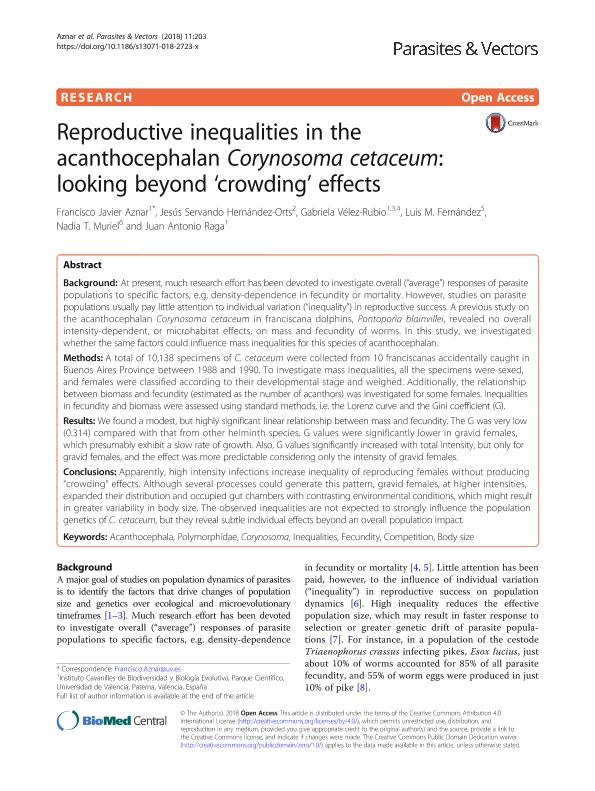Artículo
Reproductive inequalities in the acanthocephalan Corynosoma cetaceum: looking beyond "crowding" effects
Aznar Avendaño, Francisco Javier; Hernández Orts, Jesús Servando ; Vélez Rubio, Gabriela Manuela; Fernández, Luis M.; Muriel, Nadia T.; Raga, Juan Antonio
; Vélez Rubio, Gabriela Manuela; Fernández, Luis M.; Muriel, Nadia T.; Raga, Juan Antonio
 ; Vélez Rubio, Gabriela Manuela; Fernández, Luis M.; Muriel, Nadia T.; Raga, Juan Antonio
; Vélez Rubio, Gabriela Manuela; Fernández, Luis M.; Muriel, Nadia T.; Raga, Juan Antonio
Fecha de publicación:
03/2018
Editorial:
BioMed Central
Revista:
Parasites and Vectors
ISSN:
1756-3305
Idioma:
Inglés
Tipo de recurso:
Artículo publicado
Clasificación temática:
Resumen
Background: At present, much research effort has been devoted to investigate overall (average) responses of parasite populations to specific factors, e.g., density-dependence in fecundity or mortality. However, studies on parasite populations usually pay little attention to individual variation (inequality) in reproductive success. A previous study on the acanthocephalan Corynosoma cetaceum in franciscana dolphins, Pontoporia blainvillei, revealed no overall intensity-dependent, or microhabitat effects, on mass and fecundity of worms. In this study, we investigated whether the same factors could influence mass inequalities for this species of acanthocephalan.Methods: A total of 10,138 specimens of C. cetaceum were collected from 10 franciscana dolphins accidentally caught in Buenos Aires Province between 1988-1990. To investigate mass inequalities, all the specimens were sexed, and females were classified according to their developmental stage and weighted. Additionally, the relationship between biomass and fecundity (estimated as the number of acanthors) was investigated for some females. Inequalities in fecundity and biomass were assessed using standard methods, i.e. the Lorenz curve and the Gini coefficient (G).Results: We found a modest, but highly significant linear relationship between mass and fecundity. The G was very low (0.314) compared with that from other helminth species. G values were significantly lower in gravid females, which presumably exhibit a slow rate of growth. Also, G values significantly increased with total intensity, but only for gravid females, and the effect was more predictable considering only the number of gravid females.Conclusions: Apparently, competition between reproducing females increases inequality without producing crowding effects. Although the mechanism whereby this occurs is unclear, gravid females, at higher intensities, expanded their distribution and occupied gut chambers with contrasting environmental conditions, which might result in greater variability in body size. The observed inequalities are not expected to strongly influence the population genetics of C. cetaceum, but they reveal subtle individual effects beyond an overall population impact.
Palabras clave:
Acanthocephala
,
Polymorphidae
,
Corynosoma
,
Inequalities
Archivos asociados
Licencia
Identificadores
Colecciones
Articulos(SEDE CENTRAL)
Articulos de SEDE CENTRAL
Articulos de SEDE CENTRAL
Citación
Aznar Avendaño, Francisco Javier; Hernández Orts, Jesús Servando; Vélez Rubio, Gabriela Manuela; Fernández, Luis M.; Muriel, Nadia T.; et al.; Reproductive inequalities in the acanthocephalan Corynosoma cetaceum: looking beyond "crowding" effects; BioMed Central; Parasites and Vectors; 11; 203; 3-2018; 1-9
Compartir
Altmétricas



